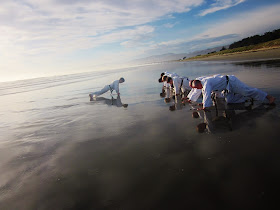Of
course after 31 years of Karate-Do, practice anyone could write a diverse range of tips on how to train kata, however,
today I decided to focus on “kata training in relation to grade” (with an
accompanying `Japanese style’ rationale, which directly relates to Karate as 'Budo' or 'Bujutsu'). Rather than write on and on, I have
attempted to do this systematically, via five tips. If you follow this approach
your karate will improve immensely. In saying that, this post is not infallible
as it doesn’t take into account people who have held, for example, a "quality" shodan rank for
many years; nevertheless, because there are numerous issues like this, logic shows
that it is impossible to address such a vast array of possibilities in a short
article. Therefore, this post aims to address kata training in relation to one's level, in the most common scenario of `standard progression' through kyu and dan.
FIVE TIPS
FOR KATA TRAINING
(1)
Don’t rush ahead to learn lots of
kata. From the beginning of your training simply stick to Heian kata practice,
and preferably put your energy into the kata for your next kyu exam. The
Shotokan syllabus is in place for a reason! If you are a brown belt simply
focus on the six kihon-gata and just one of the sentei-gata. Really aim to
master these! Also seriously practice one of the Junro kata (naturally, Junro
Shodan is recommended).
(2)
After acquiring the rank of Shodan
(first degree black belt) continue to intensely practice the six fundamental kata;
however, now also work hard to master
all four sentei-gata (Bassai Dai, Kanku Dai, Empi and Jion). Furthermore,
select one of the five Junro kata (Shodan – Godan) and aim to perfect it. You
may choose to just focus on the Junro kata you worked on previously or you
might decide to “specialise” in another.
(3)
The sixteen jiyu-gata are also
available for practice after attaining one’s Shodan, however I recommend
focusing on the aforementioned ten mandatory kata, and the Junro you like the
most. If you decide to practice a jiyu-gata focus on one (and only do this once
you are very confident with the “Big Four”). In this case, choose a jiyu-gata
that really suits you in kumite. If you have great keriwaza you might choose
Gankaku or Kanku Sho, or if you are well built and strong, perhaps Jiin, Jitte
or Sochin. Nevertheless, it is well worth mentioning that it is highly
respectable for a person taking the Nidan test to select a sentei-gata, and
ironically, the best karateka tend to. Again, quality is what counts.
(4)
There is nothing worse than seeing kyu
graded karate students doing Unsu, Sochin, Gojushiho Sho or some other advanced
kata. Yes, perhaps they can athletically emulate the movements, but the
technical maturity needed to execute these kata is impossible for karateka
without extensive training (usually holding Nidan at “the very earliest”). Using
the example of competition in the traditional sense a great Bassai Dai will
always beat a “so-so” Chinte. Likewise, a great Bassai Dai will pass the Nidan
examination but the mediocre Chinte may not. In the case of kyu examination
anything above the syllabus prerequisites will be failed. For example and likewise, if a
person taking a traditional Shodan test, performs Nijushiho, they will fail the
kata section of their exam. Overall, I think you get the idea…
(5)
Until passing Shodan the point with
kata mastery is demonstrating strong and precise kihon. After Shodan this
continues but the karateka must also know and be able to demonstrate the
oyo-jutsu (practical applications) of their tokui-gata (favourite/specialised
kata). This requires: (1) continuous training the kata as solo forms; (2) practice of the
techniques/themes/principles in yakusoku-kumite; (3) self-defence practice—with
partner compliancy—utilising oyo-kumite; and finally (4) oyo-kumite with
partner non-compliancy (literally as a form of “street style” jiyu-kumite).
None of this can be achieved with optimum form (for optimum effect in
self-defence) without a very strong technical foundation in the shitei-gata
(mandatory/compulsory kata). I.e. - knowing all of the `bunkai' is not going to help without having the physical prowess to apply it! And this is all too common in the West with numerous people producing DVDs and books on `kata applications', yet being unable to execute razor sharp fundamentals and kata... Really speaking, this is a lame form of jujutsu or judo in order to overshadow poor karate skills.
In conclusion, I
sincerely hope this article was helpful for you whether you are a beginner in Shotokan,
hold a kyu or dan rank, and/or instruct. It is critical for karateka to not
rush ahead in kata (and make their karate superficial), but rather study kata
deeply in accordance with their respective level.
Lastly, I'd personally like to wish you a very happy & healthy 2013. OSU!
- André
Bertel
© André Bertel. Christchurch, New Zealand (2013).


















